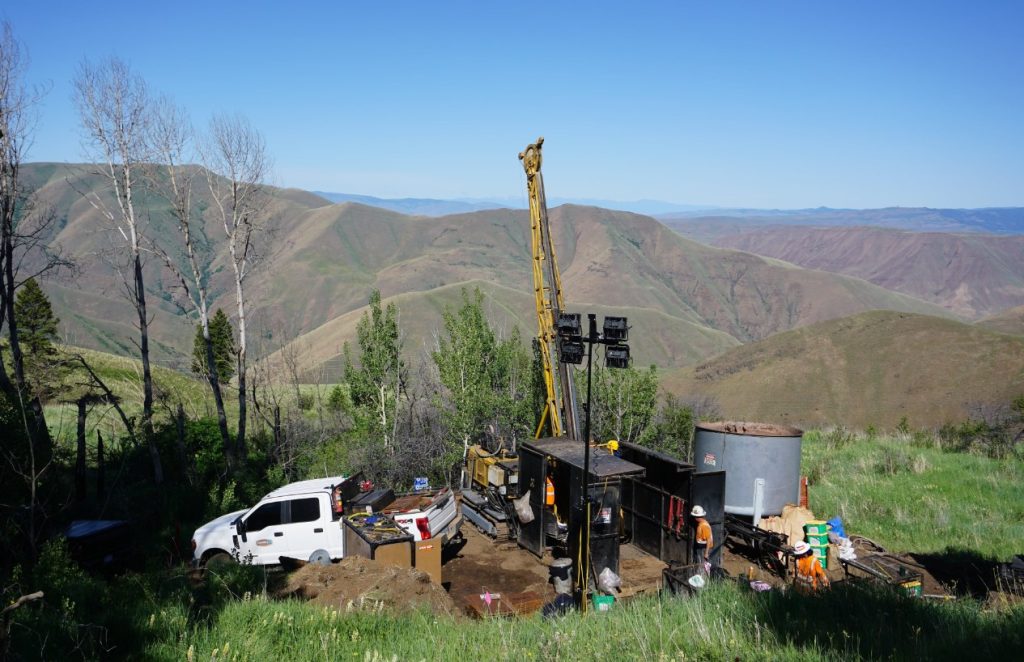Hercules Silver drills 161 metres of 0.45% copper, 148 ppm moly, 4.4 g/t silver at Hercules project, Idaho

Hercules Silver Corp. [TSXV-BIG; OTCQB-BADEF); FSE-8Q7] reported assay results for the latest holes drilled into the new Leviathan Porphyry Copper discovery at its Hercules project in western Idaho. Assay results were received in batches for three step-out holes, with complete results now having been received for HER-23-08 and HER-23-11, along with partial results for HER-23-21.
HER-23-08, HER-23-11 and HER-23-21 were collared 220 metres east, 450 metres southeast, and 500 metres southeast of discovery hole HER-23-05 respectively. Each hole was designed to test separate parts of a near surface 2022 IP anomaly. Assays for the remainder of HER-23-21, as well as HER-23-26, which also intersected porphyry copper mineralization, remain pending.
The Leviathan Porphyry remains open for expansion in multiple directions and thus far has only been tested within the 2022 IP survey area. This first phase of blind drilling has intersected copper mineralization within an approximate 500m x 450m area represented by drill holes HER-23-05, -08, -11, -21, and -26.
HER-23-21 tested approximately 800 meters of vertical extent below the silver system. All holes ended in mineralization. A new property-wide deep-penetrating IP survey demonstrates that the 2022 anomaly represents just a small part of a much larger, 4 km long, potentially zoned system which largely remains to be tested. Final geophysical inversions remain pending.
Large step-outs demonstrate significant scale to the newly discovered blind system. Significant silver overprints copper porphyry in HER-23-11, returning 183 metres of 0.3% Cu and 25 g/t Ag, including a sub-interval of 63 metres of 0.43% Cu, 70 g/t Ag.
Low arsenic associated with the epithermal silver overprinting HER-23-11, indicating favourability for potential future smelter treatment. Assays remain pending for the remainder of HER-23-21 and HER-23-26, which also intersected porphyry mineralization.
Preliminary Property-wide deep-penetrating IP reveals the potential for a much larger zoned system than was previously understood. Mineralization remains open for expansion in multiple directions. HER-23-08 and HER-23-21 ended in well mineralized volcanic country rock which remains open at depth.
Chris Paul, CEO and Director, noted: “Step out holes drilled up to 500m from the initial discovery hole, HER-23-05, have demonstrated significant scale to the system. We’ve drilled in all directions across a 450m x 500m area and every hole ended in mineralization. The system remains open in multiple directions and at depth, with new geophysical data suggesting the potential for significant expansion. Our 2023 drilling encountered a significantly large phyllic halo for which core photos have been posted to the Company’s website. The photos illustrate intense veining, sulfide mineralization and hydrothermal alteration reflective of the scale of the system. In exceptionally large porphyry coppers, the phyllic alteration can extend significant distances from a high-grade potassic core, and the intensity of veining is supportive of that.
“Utilizing large step outs has allowed us to employ property scale targeting and attracted a substantial premium investment from Barrick Gold Corp. which positions the Company to aggressively drill a new large-scale IP anomaly over several kilometers as we vector toward the potentially high-grade core of the system.”
An IP survey was carried out by Dias Geophysical in 2022 to target near surface silver in the upper plate, to a depth of 300 metres. However, the survey revealed the presence of a large chargeability anomaly below the limit of historical silver drilling which ultimately led to the discovery of the Leviathan Porphyry. With the success of the 2022 IP survey conducted by Dias, it was decided to utilize the same system again in 2023 to image the entire Property to a depth of 900 meters.
The new large-scale 2023 survey reveals that the 2022 anomaly represents just a fraction of a much larger system which does not show any apparent fault bounds, indicating the potential for significant expansion. Chargeability values are seen to increase along trend to over 33ms in magnitude, demonstrating the potential for increased levels of mineralization. Additional processing is now underway to incorporate the previous high-resolution near surface data with the new deep penetrating data, to generate a robust inversion model over the entire Property. Hercules is working with Barrick’s geophysical team to interpret the data in context with the 2023 drilling and generate the best possible drill targets for the next phase of drilling.
The company staked an additional 570 lode mining claims to the north of the Property, securing a key extension of the new 3D IP anomaly.
Hercules Silver is focused on the exploration and development of the 100%-owned Hercules Silver Project, northwest of Cambridge, Idaho.
The Hercules project is a disseminated silver-lead-zinc system with 28,000 metres of historical drilling across 3.5 kilometers of strike. The additional discovery of a new porphyry copper system at depth in 2023 adds significant upside potential to the property.
